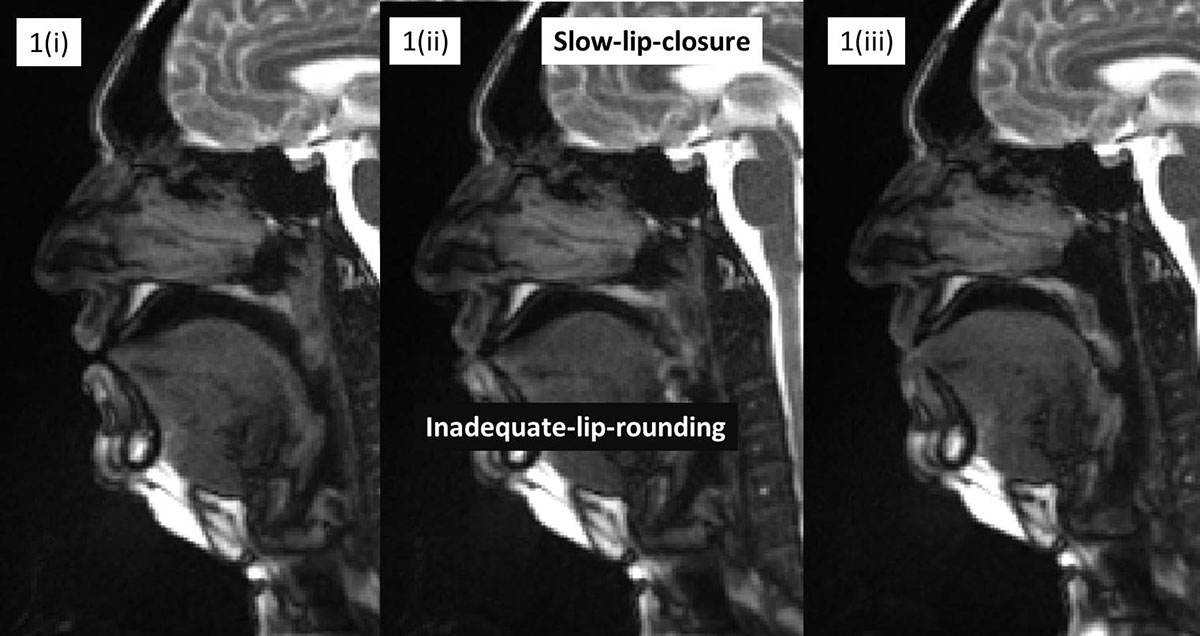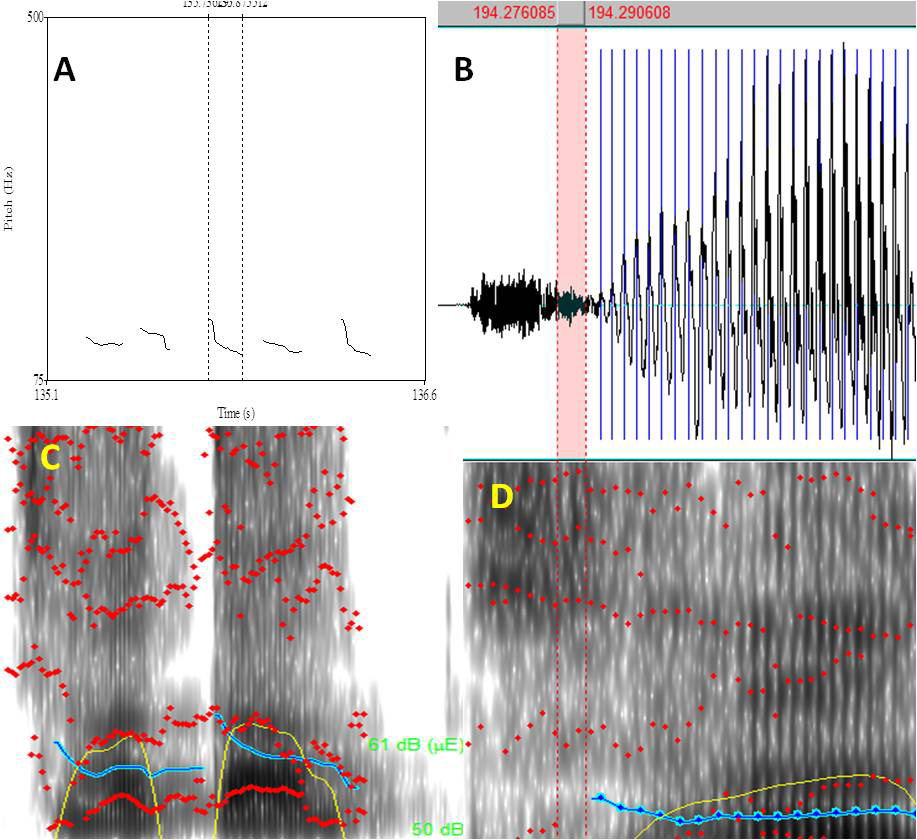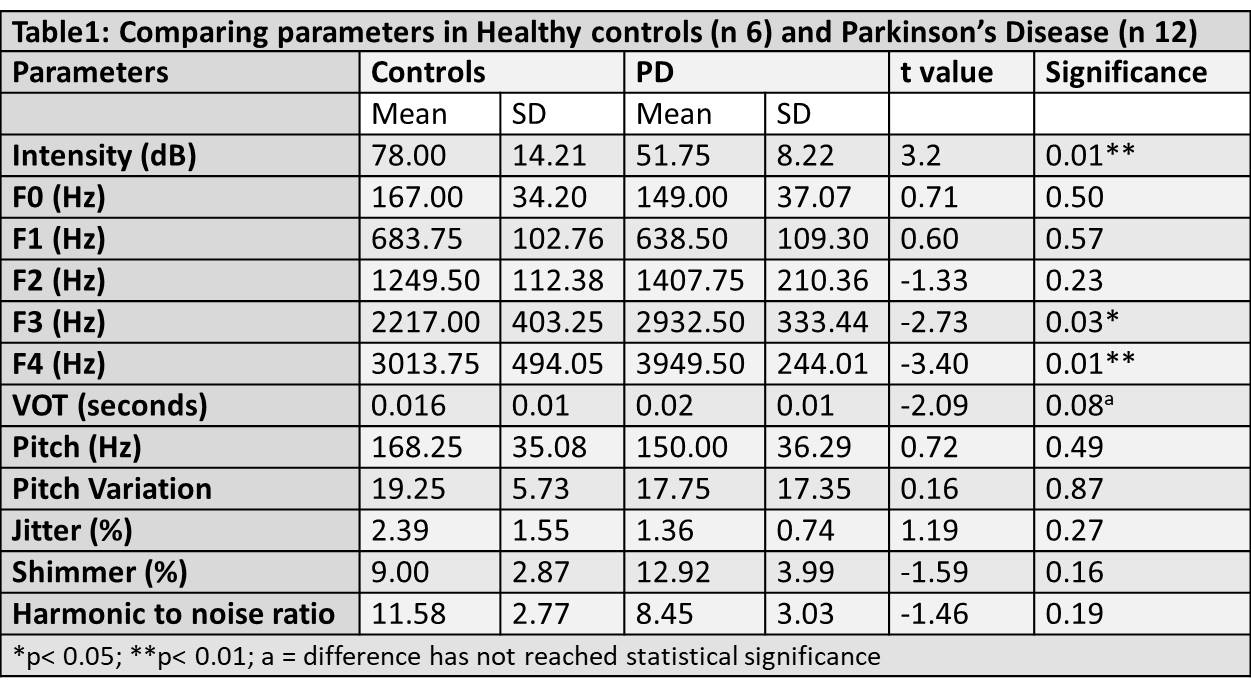Session Information
Date: Tuesday, September 24, 2019
Session Title: Parkinsonisms and Parkinson-Plus
Session Time: 1:45pm-3:15pm
Location: Agora 3 West, Level 3
Objective: Lip movements contribute to communication by producing labial sounds, conveying facial expression and aiding visually in speech perception. This study planned to understand lip-movements (orbicularis muscle) as contributor to motor speech problems in Parkinson’s Disease (PD) using acoustic analysis (spectrogram) and dynamic magnetic resonance imaging (dMRI) (articulatory analysis)
Background: PD involves progressive loss of dopaminergic neurons where imprecise vowel articulation play role as early marker[1]. Hypokinetic dysarthria observed in PD influence communication[2] that impact quality of life and self-perception[3]. Sensitive and objective parameters are required to assess the outcomes of deep brain stimulation (dysarthria also an adverse effect) [4].
Method: Sample included 12 PD patients (age range 45-70 years) and 6 age-gender matched healthy controls. dMRI acquisition single slice 2-D sagittal on 1.5T system (Aera, Siemens Healthcare, Germany) using 12H 4N and 4BFlex coils with T2 trueFISP (trufi-cine) sequence. Parameters FOV 300, TR 162.54 ms, TE 1.27 ms, FA 44ᵒ, ST 10mm, AT 8.53 min, 19.2 fps. Parameters (1)Upper-lower lip movement (2)Rate of lip-closure (Figure 1i to 1iii), (3) Lip-rounding, Lip-protrusion analyzed in ImageJ software. Recorded speech analyzed in Praat software (Spectrogram). Acoustic parameters (i)maximum phonation duration (MPD) (ii)pitch (F0 fundamental frequency) (iii)visible pitch contour (iv) voice onset time (VOT) (v) frequency formants F1- tongue height; F2- length of oral cavity; F3 – lip rounding (vi)Intensity and transmission energy (dB) (vii)Jitter (irregularities in duration/ frequency) (viii)Shimmer (irregularities in amplitude/intensity) (ix)voice breaks and (x)harmonicity (dB) Group analysis done with ‘t’- test using SPSS [Table1]
Results: dMRI show differences in lip-rounding, closure-rate, release-rate and inadequate lip-protrusion in PD. Formants F3 and F4 are significantly different indicating resonance changes associated with lip-movement[5]. Intensity difference between the groups shows lower transmission energy or loudness in PD[1,6,7] Figure1: Lip-movement acquired with dynamic MRI during speech production Figure2: Spectrogram analysis of speech (A-pitch contours; B-VOT; C-Formants; D- regularity in intensity)[Figure2]
Conclusion: Deviations in lip movements may contribute to oromotor dysfunctions in PD
References: 1] Rusz, J., Čmejla, R., Růžičková, H. et al., 2013. Evaluation of speech impairment in early stages of Parkinson’s disease: a prospective study with the role of pharmacotherapy. J Neural Transm 120: 319. https://doi.org/10.1007/s00702-012-0853-4 [2] Skodda S., Visser W., Schlegel U. 2011. Acoustical Analysis of Speech in Progressive Supranuclear Palsy. Journal of Voice, 25, 725-731 [3] Cruz AN, Beber BC, Olchik MR, Chaves ML, Rieder CR, Dornelles S, 2016. Aspects of oral communication in patients with Parkinson’s disease submitted to Deep Brain Stimulation. Codas. 28(4):480-5. doi: 10.1590/2317-1782/20162015169. [4]Vogel et al, 2015.The feasibility of using acoustic markers of speech for optimizing patient outcomes during randomized amplitude variation in deep brain stimulation : a proof of principle methods study. Front. Bioeng. Biotechnol.3:98.doi:10.3389/fbioe.2015.00098 [5] Boersma P, Weeninck D, 2019. Interpreting vowel articulation from formant frequencies. https://swphonetics.com/methods/vowel-articulation-from-formants/ [6] Chiba T, Kajiyama M, 1941, The Vowel, its Nature and Structure, Tokyo Publishing Company, Tokyo. [7] Pinho P, Monteiro L, Soares MFP, Tourinho L, Melo A, Nóbrega AC, 2018. Impact of levodopa treatment in the voice pattern of Parkinson’s disease patients: a systematic review and meta-analysis. Codas. 4;30(5):e20170200. doi: 10.1590/2317-1782/20182017200.
To cite this abstract in AMA style:
P. Upadhyay, S. Gudwani, K. Sharma, R. Sagar, R. Dhamija, S. Kumaran. Lip movement contribution in speech production of persons with Parkinson’s Disease [abstract]. Mov Disord. 2019; 34 (suppl 2). https://www.mdsabstracts.org/abstract/lip-movement-contribution-in-speech-production-of-persons-with-parkinsons-disease/. Accessed December 19, 2025.« Back to 2019 International Congress
MDS Abstracts - https://www.mdsabstracts.org/abstract/lip-movement-contribution-in-speech-production-of-persons-with-parkinsons-disease/



